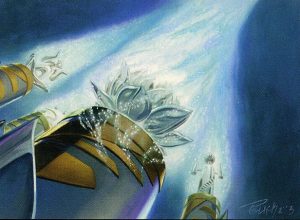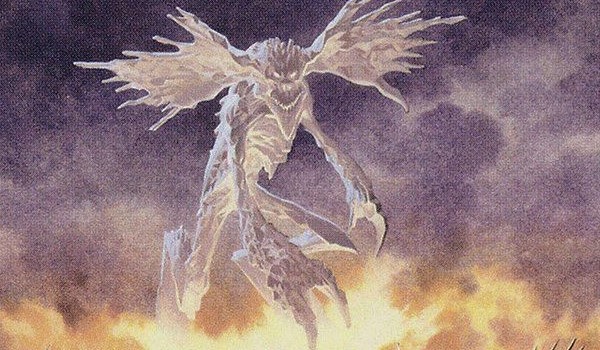Are you a Quiet Speculation member?
If not, now is a perfect time to join up! Our powerful tools, breaking-news analysis, and exclusive Discord channel will make sure you stay up to date and ahead of the curve.
Hello, fellow creature enthusiasts! Welcome back to Magical Creatures, a series on uniqueness among Magic designs. In the first article, I proposed a way to select creatures "unique" to this game, such as Atog, Beeble, and Cephalid. And last week, we discussed half of the new creatures of this sort from the Mirrodin block: Myr, Pentavite, and Slith.
As we mentioned in the past installment, Mirrodin and its two follow-up expansions (Darksteel and Fifth Dawn) were packed with new creature types. And six of these were not only new to Magic, but to all of fantasy. As such, they are all perfect for this series, and today we'll have a look at the rest: Vedalken, Blinkmoth, and Bringer.
As with last week, one creature type is going to be huge, while the other two will be more modest. Can you guess which one appears on the greatest number of cards? They don't have a particularly celebrated record in tournament history, but this type is undeniably the most widespread tribe among the six analyzed in this double piece...
Vedalken
Yes, Vedalken are even more numerous than Myr (62 against 38)! The fact is creatures with the Myr subtype only appeared in the Mirrodin and Scars of Mirrodin blocks, with very few exceptions. On the other hand, Vedalken may have had a few dedicated cards in the Mirrodin block, but they kept popping up in the following years.
"Original" vedalkens from the Mirrodin block
So what is a vedalken? Well, the first thing we can tell is they are very blue creatures. In fact, although Vedalken of all five colors exist, blue is always the main color, present in each and every creature of this type. That being said, we can also agree that they are humanoid beings, with hairless, blue skin. Don't forget that Vedalken is just the race, though! So, what about the class?
Vedalkens of several different classes have been printed over the years, including Rogue, Soldier, and even Knight. However, the most represented class by far is Wizard, with roughly 30 cards. In second is Advisor, with approximately 15. This clearly shows that their main qualities pertain to the mind's domain, as one would expect from such a blue creature.
Vedalken Killed the Merfolk Star?
As a matter of fact, Vedalken creatures are obsessed with knowledge and hyper-intellectual. In some respects, they could remind of another typical blue creature: Merfolk. And not by chance! When Mirrodin came out, in late 2003, Merfolk was in the process of being abandoned as the main representative blue race. The reason? The simple fact that they were limited to watery environments. To put it bluntly, as Doug Beyer did, Merfolk "just don’t do what an iconic race needs to do, which is walk."
What about competitive play? Most of them didn't make the cut, but Master of Etherium certainly is a huge exception! In the past few years, it's mostly been played at just one copy, as you can see from Tuan Nguyen's result at the 2018 Magic Online Championship. In the past, though, it was even stronger. Other notable Vedalken are Grand Architect and Vedalken Archmage, since both can prove to be pretty versatile, and are particularly strong in combos.
Blinkmoth
Time to leave Mirrodin and move to the second set of that block: Darksteel. Released in early 2004, Darksteel is particularly infamous for generating two overpowered cards: Aether Vial and Skullclamp. Apart from that, it kept running the huge artifact theme, and gave us a new creature type unique to Magic: Blinkmoth. Well, it also introduced Artificer, but that's definitely not new.
Blinkmoths and their best friends
Let's make it clear from the start: no card was ever printed with the Blinkmoth subtype. And yet, it's among the numerous creature types that any creature with changeling would have. How come? We discussed similar cases in Tetravite, Pentavite and Triskelavite? And the same thing happened with Saprolings. The fact is all these creature types only exist in the form of tokens.
With Blinkmoth, things are a bit different. It's an artifact creature representing a small, flying insect-like creature, very common on Mirrodin. But it doesn't come as a token. The only way to have a Blinkmoth is to animate either Blinkmoth Nexus or Inkmoth Nexus. These two lands can tap for colorless mana, or they can turn into a 1/1 flying Blinkmoth until end of turn.
Animated Lands in Competitive Play
The former was used both in standard and extended tournaments, as it gave Affinity decks a boost (as if they needed it, right?). When transformed in an artifact creature, it helped for the affinity count, and even better, it could be equipped with Cranial Plating. It was even played in Burn, either to inflict the last hits or to sacrifice for Shrapnel's Blast's sake.

As for the latter, it didn't only have flying, but also infect. Which of course made it much stronger, but at the same time limited its use to decks taking advantage of the infect mechanic. For instance, at the World Magic Cup 2012, Stjepan Sučić brought a list of Mono Green Infect to the Top 8!
Bringer
The last creature type we're discussing today is Bringer. And I'm sorry to say this tribe is neither numerous nor competitive. Only five Bringers exist, they all come from Fifth Dawn, and they obviously form a cycle.
Just a few words on this third set from the Mirrodin block, before passing to Bringer: Fifth Dawn, released in the summer of 2004, finally fixed the issue of printed artifact cards looking too similar to white cards color-wise, by darkening the gray border. Apart from that, it introduced some unique and enduring artifacts, such as Crucible of Words, Engineered Explosives and Krark-Clan Ironworks.
Okay, there is not much to be said about Bringer. The tribe's best feature, if you ask me, is its illustration. Five different artists created them, including Kev Walker and Carl Critchlow. Each of them gave his take on these weird crystalline beings, with results that are different, but equally astonishing.
Each Bringer costs nine mana (seven generic and two specific), but you can pay only five by using one mana of each color. That's the main theme of Fifth Dawn, after all, as indicated by the sunburst mechanic. Indeed, Bringers themselves are manifestations of the very energy of the five suns (well, technically moons) of Mirrodin.
They are all 5/5s with trample which do something big at the beginning of your upkeep. Which is great, but not for that much precious mana. Anyway, when we were beginners, this certainly didn't stop most of us from yearning for the five bringers... but then again, didn't we pine the same after Enormous Baloth?
Variety vs. Versatility
Among today's three creature types, my favorite is probably Blinkmoth, because of its versatility despite only two cards mentioning the type. Blinkmoth was not the first "manland:" we'd had plenty before and would get many later, including the celebrated Mishra's Factory. Nevertheless, Blinkmoth Nexus and Inkmoth Nexus are the only two lands that transform into creature with a subtype invented specifically for Magic.
Vedalken were also an interesting addition to the game, at least from the point of view of variety. Speaking of which, in the next installment, we'll meet yet another blue tribe that might remind you of Merfolk and Vedalken. It comes from the Kamigawa block... can you guess what I'm talking about? Stay tuned to find out!





